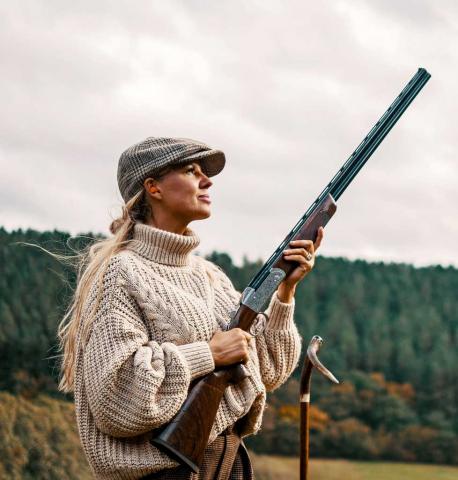Shotgun Tips – Trying To Do The Same Thing
Accepting the variability swing to swing and shot to shot was a huge understanding for me as a shooter and as a coach! Knowing that I can’t make the same perfect move mount and shot every time I call pull, allows for me to let my subconscious take care of set up and when and how the mount is completed. This keeps it out of my visualization and does not allow for it to clutter it up with things that don’t need to be there.
My visual process is the last 10-12% of the shot and it is very detailed with respect to HOW THE SHOT COMES TOGETHER! In our research we have discovered that consistently applying the correct lead is more a result of how the shot comes together instead of something that you pre-program.

Just like you cannot, “not think”, you cannot shoot consistently without being aware of the barrel. Albeit a small awareness trying to feel your way through the shot and not see the barrel is futile and establishing an awareness of the muzzle in the periphery is an evolution (to each his own) and is what deliberate practice is all about!
This topic in great measure was the genesis of our Kill Shot Reviews on our Knowledge Vault and shooters who are watching them (on both clays and game birds) before practice and before a tournament are shooting remarkably better scores with less practice! Perceptual Cognitive Learning is what this is called and when the KSRs are watched intently and the shooters brain finds itself in a situation that it has seen perfectly executed over and over two things happen. It is easier for the shooter to visualize in detail how the shooter wants the brain to bring the shot together and where. Both sides of the brain are involved with the shot and have a very specific task as the shot comes together making it easier for the shooter to slip into the zone shot after shot!
The left brain is programmed to see the target on the correct side of the barrel and to send the shot when the speed is matched, which frees up the right brain to adjust the lead while matching the speed. After the speed is matched and the shot is taken everything is moving in such slow motion, if the target breaks it can be replicated and if not the reason for the miss is so obvious it is easily corrected on the next shot.
The key to being able to execute this in practice and eventually on game day is two-fold. The shooter must predict in detail how they want the shot to come together and they then must commit to the shot according to their plan. It is the prediction that sends the successful shot to the long-term memory. Any success without a prediction that is detailed and committed to, will simply be a product of how well you felt that day and will be forgotten due to it remaining in your short-term memory and your short-term memory is an expert at forgetting things!
This is why you can go to a troubled shot and after 8-10 shots you can “find it” and repeatedly hit the target over and over. When you see the target next, it is as if you never practiced it. It stayed in your short-term memory due to no prediction and without a prediction there is nothing to commit to but the lead! So you experienced what the short-term memory does best …..when another task is taken on it forgets what it was just doing.
Deliberate practice is about predicting what you are about to do and committing to do just that. The more detailed the prediction the clearer it becomes for both sides of the brain to be comfortable with their task at hand. Then they become so much better at doing what you want them to do because they have done it together so many times. This is how you build a library of sight pictures that you can access any time on any shot, which in turn creates confidence, which in turn creates competence that allows for consistency.
Watching the KSRs allows for this visual process to be virtually automatic and happen with less and less thought. The more skillful you become at any thing the less detailed information you need to have for higher and higher levels of performance.
To do anything, the brain must have a mental representation of what it is about to do. The better the mental representation the better the shot and the better the shot the better the mental representation and so on. It becomes a virtual circle when you predict and commit to the prediction. This is what deliberate practice is all about and why there are so many shooters that have spurts of success, but never reach the consistency they seek regardless of how much they “practice”.
So we now understand that building a library of sight pictures is critical and it is the prediction and execution based on that prediction that is key to building long term memory in our brain and in great measure allows for us to trust what we are about to do.
We also need to share with you something else we have learned about this trusting of yourself to be able to shoot without thinking because as you have learned if you are thinking while the target is in the air nothing good happens.
So how does this not thinking occur or how do we learn to just trust it and let it happen like all the self-help books talk about? Well let us see if we can unravel that mystery, as we now understand it. The core purpose of our visual processing system is prediction and this skill is the ability to anticipate ahead of where you are. Hitting a moving target in the air with a shotgun consists of seeing the target where it is and shooting where it will be or where you anticipate it will be. The better you get at doing anything, the farther in front of where you are, you can anticipate and the less you have to actually be aware of when performing.
What really occurs is a process called chunking where the brain takes the many things that must come together for you to do something like say, flip two eggs over in a non-stick fry pan without breaking the yolks and through repetition it makes the action seem automatic. You just flip the eggs (without thinking). It doesn’t matter whether we are flipping eggs or moving and mounting the gun in front of the bird, you must have done it the same way enough times so that your brain has chunked the movements necessary to complete the act consistently into one.
We now understand that it is the sequencing of the events leading up to the moving and mounting of the gun that allows for the anticipation to occur. In the sequence of events, what must be learned is the move and mount, so it happens without thinking. The visualization of the sight picture and how the shot will come together, where and then repeating the sequence of events that lead up to calling pull. When all these things have been repeated enough that the sequence of events that leads up to calling pull happens the same way each and every time, then the brain can begin to anticipate farther ahead as the sequence begins. It’s like as you begin the sequence the brain knows what is about to happen before it happens and this allows you to shoot without thinking.
First you must have a move and mount that are 95% perfect 100% of the time. Then you must be able to visually predict how and where you want the shot to come together and then you must have practiced the sequence leading up to calling pull enough times so as the sequence begins the brain says, “I’ve been here before, I’ve got this lets roll!”
Before you can really work on performance and shooting while not thinking, you must do your home work on basic fundamentals and get those down before you can even begin to work on mental performance. We must tell you how fun it is for us to see shooters brains begin to react better and better as the sequence begins to become ingrained into their game. The feeling they get and we see is an incredible evolution from trying, to doing, without thinking. –Gil & Vicki Ash



